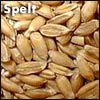All About Spelt

Spelt comes from a wheat-like plant whose seed somewhat resembles wheat but is a bit longer and more pointed. Just like hard red winter wheat, Spelt must be planted in the fall of the year, maturing the following summer. It is an ancient grain that has been grown all over Europe for the last 9,000 years and is also referred to in the Old Testament of the Bible. In fact, it is believed that only the grains Emmer and Elkorn have preceded Spelt in being domesticated. Here in the United States, Spelt was brought by Swiss Immigrants to the Eastern Ohio and from that time spelt was a very common grain grown for hundreds of years throughout the United States. During the 20th Century, it was almost completely abandoned for the more modern varieties of wheat which had a higher yield, shorter growing season and better resistance to disease. In Europe, especially during the Middle Ages, Spelt was grown for human consumption and also animal feed. Here in the United States, until recent times, Spelt was grown mostly as feed. However, since the mid 1980's, Spent has made a real inroad into the health food market as a wheat substitute.
Many people who are allergic to wheat can tolerate Spelt. However, many allergy doctors believe that Spelt is too closely related to wheat for it to be an effective replacement grain. They feel that even though wheat sensitive people might be able to tolerate it now, as time goes by they will develop wheat-like allergies to it. However, companies that exclusively sell Spelt products to people, many of them with wheat allergies, say their customers have had really good luck eating Spelt goods. Spelt has a lower gluten strength which makes it possible for many people with gluten allergies to eat this product. Purity Foods, one of the main marketers of Spelt say that out of thousands of their customers with wheat allergies, only 16 of them have reported allergic reactions to Spelt. An Ohio bakery that specializes in making spelt products and distributes them over several different states has numerous customers who can't tolerate wheat yet can eat Spelt products. It seems, for the wheat intolerant among us, Spelt is probably worth a try. If you are allergic to wheat and you want to use Spelt, please consult your doctor before trying this product, then use adequate safeguards when trying Spelt to prevent serious complications should you also be allergic to this product.
Spelt contains 15 - 21% protein which is much higher than wheat. It's also higher than wheat in complex carbohydrates, iron, potassium and the B Vitamins. Spelt is easier to digest than wheat products because of it's higher solubility in water. Spelt also contains nutrients that aid in blood clotting and also stimulate the immune system. Due to Spelt's high water solubility and fragile gluten, the grain's vital substances can be absorbed quickly by the body with a minimum of digestive work. Spelt contains special carbohydrates which play a decisive role in blood clotting and stimulate the body's immune system. It's high fiber content aids in reducing cholesterol and heart disease. It's also nice to know that something as healthy as Spelt also has a great flavor. Spelt is just another example of what great nutrition should taste like.
Cooking with Spelt flour is similar to cooking with wheat flour. You can make all the same dishes such as pancakes and waffles, muffins, cakes, crackers and cookies, pastas and breads. Because of it's lower gluten content, however, you will probably not wish to let it rise as high as regular wheat flour bread. When baking, Spelt flour doesn't require as much water - if substituting spelt flour for wheat flour in your favorite recipe, start by using only 3/4ths as much water.
Recipes:
http://www.sfn.saskatoon.sk.ca/business/steephill/speltrec.html
http://www.around.ntl.sympatico.ca/~jroberge/srecipe.html
References:
The Prudent Pantry by Alan T. Hagan
http://207.87.221.23/~frenchs
http://www.purityfoods.com/furrow.html
http://www.spelt.com